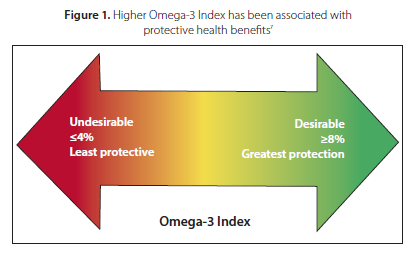Eicosapentaenoic acid (EPA) and docosahexaenoic acid (DHA) are
long-chain omega-3 polyunsaturated fatty acids (PUFA). Biosynthesis of
EPA and DHA from other fatty acids is poor, and as a result EPA and
DHA are considered “conditionally essential” nutrients required in the
diet for optimal health.1
| Download the PDF |
EPA and DHA nutrient gap
On average, the daily intake of EPA and DHA, plus estimated EPA equivalents (endogenous biosynthesis from other fatty acids) from food and supplements, among American adults is 170 mg per day.2 Ninety-percent of people consumed less than the minimally recommended 500 mg per day,3 and reported consumption is markedly below amounts that promote therapeutic benefits. This nutrient gap is presumably not being met through the intake of fish oil supplements, as only 6.2% of US adults report taking fish oil supplements within the past 30 days.2
How do I measure EPA and DHA status?
Omega-3 Index is a test that can give an indication of EPA and DHA
status. Lower results on the Omega-3 Index test have been associated
with increased risk of cardiovascular disease and cardiovascular risk
markers and have also been linked with depression.4-5 Consumption of
EPA and DHA has been shown to increase the Omega-3 Index in a
dose-dependent manner.6

What is the difference between ethyl ester (EE) and
triglyceride (TG) forms?
The question of whether TG or EE supplements lead to better outcomes
has been the subject of controversy and has received a lot of research and
clinical attention. However, a consensus has not been reached in the
literature regarding which form is preferable.
In fish, fatty acids are found in a TG form, meaning that three fatty acids are
attached to a glycerol backbone. To concentrate EPA and DHA in fish oil,
these natural TG molecules are broken apart, and the resulting EPA and
DHA free fatty acids are esterified to an alcohol backbone to form an EE.
Of note, these EE molecules can be broken down, and the released EPA
and DHA free fatty acids can be then reesterified back to a TG (reesterified
TG form), facilitating the development of more concentrated EPA and DHA
TG oil.
Pharmacokinetic studies that have examined EPA and DHA increases in
plasma generally show that these fatty acids are higher in the hours
following supplementation in the TG compared to EE form.8-10 However,
both EE and TG forms of EPA and DHA supplements have been shown to
drive improvements in clinical outcomes.
What do studies show about dosing of EPA and
DHA supplements?
Consuming higher amounts of EPA and DHA, not unexpectedly, leads to
greater increases in EPA and DHA status.11 Studies that have examined the
difference in status after daily supplementation or delivering as a bolus
dose twice weekly (with both delivery options providing the same amount
of EPA and DHA) showed that daily intake led to faster improvement in EPA
and DHA status and higher status after one year,12 suggesting that
consuming EPA and DHA daily is advisable. Numerous clinical research
studies have also shown that EPA and DHA supplementation can promote
a variety of specific therapeutic outcomes and benefits.


